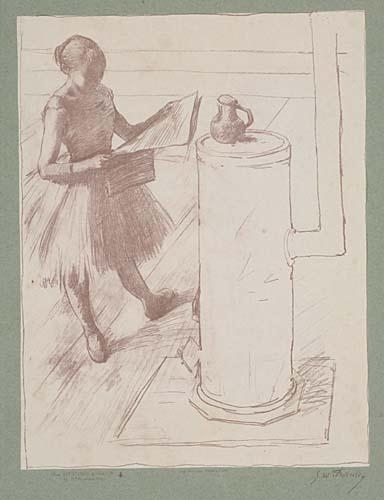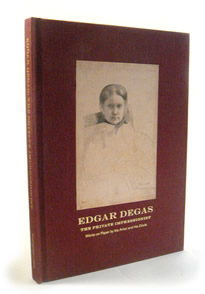Polk Museum of Art at Florida Southern College, Lakeland, FL
Dec 22, 2018 – Mar 24, 2019
Dec 22, 2018 – Mar 24, 2019
The works in the exhibition show an unexpected side of Degas — namely as a masterful draftsman, . In addition to drawings, etchings, lithographs, and monotypes, the show features Degas’ photographs and a bronze sculpture. The exhibition also includes more than 40 works on paper by Degas’ artist colleagues, including Mary Cassatt, Édouard Manet, Paul Cézanne, Jean-Auguste-Dominque Ingres, Honoré Daumier and Henri de Toulouse-Lautrec.
Many of the subjects commonly associated with Degas’ work are featured in this exhibition, including ballerinas, horses and jockeys, café concert singers, bathers, beach scenes, and portraits of Degas’ peers.
“The exhibition presents Degas lovers with an intimate glimpse at his early drawings, as well as works from his more mature period during which he created the unique visual explorations of Parisian life that have gained him global renown,” Rich said.
Ballerinas were Degas’ most familiar subject, and he was known for depicting them often in scenes of everyday life.

For example, a lithograph from 1889, “Danseuse prés de la poêle,” depicts a ballet dancer not rehearsing or performing but standing beside a stove reading a newspaper.

For example, a lithograph from 1889, “Danseuse prés de la poêle,” depicts a ballet dancer not rehearsing or performing but standing beside a stove reading a newspaper.
The earliest of his works in the show is an 1853 graphite drawing of his brother Achille, created when Degas was 19 years old and his brother was 15. In the portrait, Achille sits comfortably, slightly slouched and with one arm draped informally over the back of the chair upon which he sits, while appearing to look out just beyond the viewer as if lost in thought.
The self-portraits in the exhibition — including a view in profile and an etching — illustrate how Degas saw himself as a young artist and help viewers visualize the man behind the legend. Many etchings in the show, like an 1857 self-portrait, speak to Degas’ manner of creating art and to his eye for the future commercial potential for his work,
Etchings in the exhibition are from plates Degas sold to Ambroise Vollard, an art dealer, publisher and distributor of prints by contemporary master artists. Before selling his etched plates to Vollard around 1910, Degas canceled them by incising a few thin lines through the final plates to make any further printings from them — especially any made after his death — notably less pristine than those first ones he printed by his own hand.
“Prints made from Degas’ canceled plates look like they have scratches in them as a result, but this was Degas’ intention when he sold the plates for future printing,” Rich said.
Although the plates and the cancellation lines are rendered by Degas, prints made from the canceled plates can forever be distinguished by their imperfect compositions. Degas wanted Vollard’s and others’ future versions of his prints to be distinct from those impressions made during his lifetime, Rich said. “The posthumous life of many of Degas’ works — including his now-beloved bronze sculptures which were cast only after his death after models found in his studio — offers a fascinating art history lesson in itself.”
The collection featured in the exhibition belongs to Robert Flynn Johnson, an art historian and art connoisseur, who curated the show from the works he has amassed over the past four decades.
 |
 |
 |
 |
 |
 |
 |
 |
 |
Edgar Degas
The great French
artist Edgar Degas (1834–1917) once said, “I would like to be
illustrious and unknown.” To a large degree, his wish has been granted.
By the time of Degas’ death, more than ninety years ago, his art had
become famous; his reputation since then has only grown.
Yet
the individual who was so accomplished in many artistic endeavors—from
drawing, painting, and printmaking to sculpture and photography—has
remained elusive. Unjustly labeled a misogynist because of his frank
depiction of women, and a cynic because of his biting wit, Degas was,
rather, arguably the keenest artistic observer of human nature since
Rembrandt. And, although often aloof to strangers, Degas shared warmth
and loyalty with his family as well as with a wide circle of friends,
which included some of the greatest writers and artists of the epoch.
The works by Degas in this exhibition consist of twenty-four drawings,
twenty prints, eight photographs, three monotypes, one sculpture, and a
letter, all from a single private collection. The collection endeavors
to illuminate the background and personality of Edgar Degas the man, as
well as to present his genius as an artist. The subject matter of these
works by Degas is often quite personal.
In addition to three rare self-portraits, the collection includes depictions of his father, his
brother Achille, an Italian niece, his loyal housekeeper Sabine Neyt, and the wife of a patron, Madame Ernest May; three
portraits of Édouard Manet and two of Mary Cassatt; and drawings after
antique sculpture and Old Masters such as Mantegna and Michelangelo.
Works touch upon three notable themes of Degas’ oeuvre: the human body,
horse racing, and the ballet. Also included is a group of brilliant
color aquatints after Degas monotypes by Maurice Potin, which were
commissioned shortly after the artist’s death by the owner of the
original monotypes, Degas’ friend and dealer, Ambroise Vollard. An
additional selection of more than forty rare works of art on paper
enriches the exhibition. These pieces are by well-known artists, many of
whom were friends of Degas.
Enriching the exhibition are an additional selection of more than forty rare works of art on paper by
well-known artists, many of whom were friends of Degas, including
Giovanni Boldini, Mary Cassatt, Paul Cézanne, Marcellin Desboutin,
Jean-Hippolyte Flandrin, Jean-Léon Gérôme, Jean-Auguste-Dominique
Ingres, Alphonse Legros, Adolph von Menzel, Gustave Moreau, Henri
Regnault, William Rothenstein, Alfred Stevens, Henri de
Toulouse-Lautrec, and Joseph-Gabriel Tourny.
The exhibition is further enhanced by several drawings by Pierre-Georges Jeanniot, one of Degas’
closest friends during the final decades of his life. The group of
Jeanniot drawings comprises portraits of the sculptor Albert Bartholomé
and Degas’ younger disciple Jean-Louis Forain, three self-portraits, and
two exceedingly rare portraits of Degas himself, who was famous for his
reluctance to pose. These works have never before been exhibited
together publicly and provide a delightful exploration into the art and
personality of one of the most skilled, intelligent, and complex artists
in the history of art.
This exhibition is co-curated by Robert Flynn Johnson, Curator Emeritus of the Achenbach
Foundation for Graphic Arts, Fine Arts Museums of San Francisco.and
Louise Siddons, Ph.D., Assistant Professor and Curator of Collections at
Oklahoma State University, Stillwater.
 |
A hardcover full-color 126 page catalogue
has been published with a preface by Degas expert, Ann Dumas, Curator of
The Royal Academy, London, & other essays.
|
This exhibition, formally titled “Edgar Degas, The Private Impressionist: Works on Paper by the Artist and His Circle,” was organized by Landau Traveling Exhibitions in Los Angeles, in association with Denenberg Fine Arts in West Hollywood.
Complete list of works